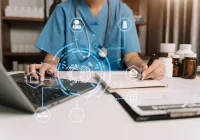Wearable medical devices are changing healthcare delivery by shifting care beyond traditional settings and bringing it closer to patients’ daily lives. By offering continuous monitoring, promoting patient engagement and supporting remote interventions, these technologies are becoming an essential part of modern care. Medical-grade devices such as continuous glucose monitors and cardiac sensors already demonstrate their ability to support chronic disease management and diagnostics. At the same time, data from wearables is contributing to clinical research and public health forecasting. With the global market projected to grow sharply in the coming years, the challenge now is to expand access and integration while maintaining accuracy and safeguarding patient data.
Expanding Use of Medical-Grade Devices
Healthcare wearables fall broadly into consumer-grade and medical-grade categories. Consumer devices, including fitness trackers and smartwatches, are popular for recording sleep, steps or heart rate but lack the clinical precision needed for decision-making. Medical-grade devices, in contrast, are subject to regulatory oversight and validation, making them suitable for clinical care. Examples include continuous glucose monitors, electrocardiogram monitors, smart patches for drug delivery, respiratory monitors and smart hearing aids.
These devices are increasingly integrated into treatment pathways where accuracy and reliability are critical. Continuous glucose monitors provide real-time information on blood sugar fluctuations, while cardiac monitors enable the detection of arrhythmias outside hospital walls. Blood pressure wearables, sweat sensors and targeted drug-delivery patches are supporting personalised treatment plans that adapt to patients’ unique conditions. The distinction between consumer and medical-grade technology is becoming more visible as the latter secures a stronger role in proactive and preventive care.
Benefits for Patients and Health Systems
The value of wearables lies not only in measurement but in the transformation of care practices. Continuous monitoring delivers round-the-clock visibility into physiological signals, helping clinicians detect trends and intervene earlier. At-home monitoring after surgery or during chronic disease management reduces reliance on hospital-based assessments and eases the burden on outpatient clinics.
For patients, wearable devices encourage greater involvement in their own health. Even consumer-grade devices, although less precise, provide valuable feedback on lifestyle, activity levels and sleep patterns. This supports behaviour change and allows individuals to make informed decisions about diet, exercise or medication adherence. The empowerment derived from real-time information builds confidence and fosters a stronger partnership between patients and their providers.
For healthcare systems, cost efficiency is a major benefit. By reducing unnecessary in-person visits and enabling telemedicine consultations, wearables lower overheads and free up resources. Diagnostic processes are accelerated as continuous streams of information complement clinical assessments. In diabetes care, for example, AI-enabled continuous glucose monitors predict fluctuations influenced by food, activity or stress, allowing treatment adjustments in real time. Cardiology also benefits, as wearable cardiac monitors reveal patterns that may be missed during brief in-clinic testing.
Must Read: Wearable AI: Elevating Patient Safety and Precision in Clinical Care
Beyond individual care, wearable devices contribute to population health research. Aggregated, anonymised data provides insights into community-level health trends, guiding preventive strategies and resource allocation. During the COVID-19 pandemic, data from wearables helped forecast regional outbreak probabilities days in advance, highlighting their role in public health monitoring.
Challenges to Widespread Adoption
Despite strong progress, several hurdles still restrict broader use of wearables in clinical practice. Data privacy is one of the foremost issues. Devices capture highly sensitive health information, making robust safeguards essential. Advances such as blockchain technology are beginning to strengthen protection but concerns remain over potential misuse or breaches.
Integration with electronic health records presents another obstacle. Without common standards across platforms, information often sits in isolated systems, limiting its usefulness for clinicians. Cloud-based solutions and automated processing are easing the problem, but interoperability continues to require investment and coordination.
Cost and access are also significant concerns. Medical-grade devices remain more expensive than consumer alternatives, restricting use to patients with strong insurance coverage or to better-funded healthcare organisations. This raises questions of equity, as disadvantaged populations risk being excluded from the benefits of digital monitoring. Over time, wider adoption and continued innovation are expected to reduce costs and expand availability, but disparities remain a present reality.
Accuracy and reliability are further challenges. Device performance can be affected by sensor quality, calibration or placement on the body. Inconsistent readings limit trust and restrict use in critical decision-making. Encouragingly, ongoing research is improving both hardware and algorithms, making devices more dependable for clinical integration.
Wearable technology is evolving into a cornerstone of connected and proactive healthcare. By enabling continuous monitoring, personalising treatment and generating data for both clinical care and public health, these devices are reshaping how care is delivered. Although challenges around privacy, integration, access and accuracy remain, innovation is steadily addressing them. With adoption growing, wearable medical devices are set to play an increasingly central role in building smarter, more efficient and more patient-centred healthcare systems.
Source: Healthcare Transformers
Image Credit: iStock










